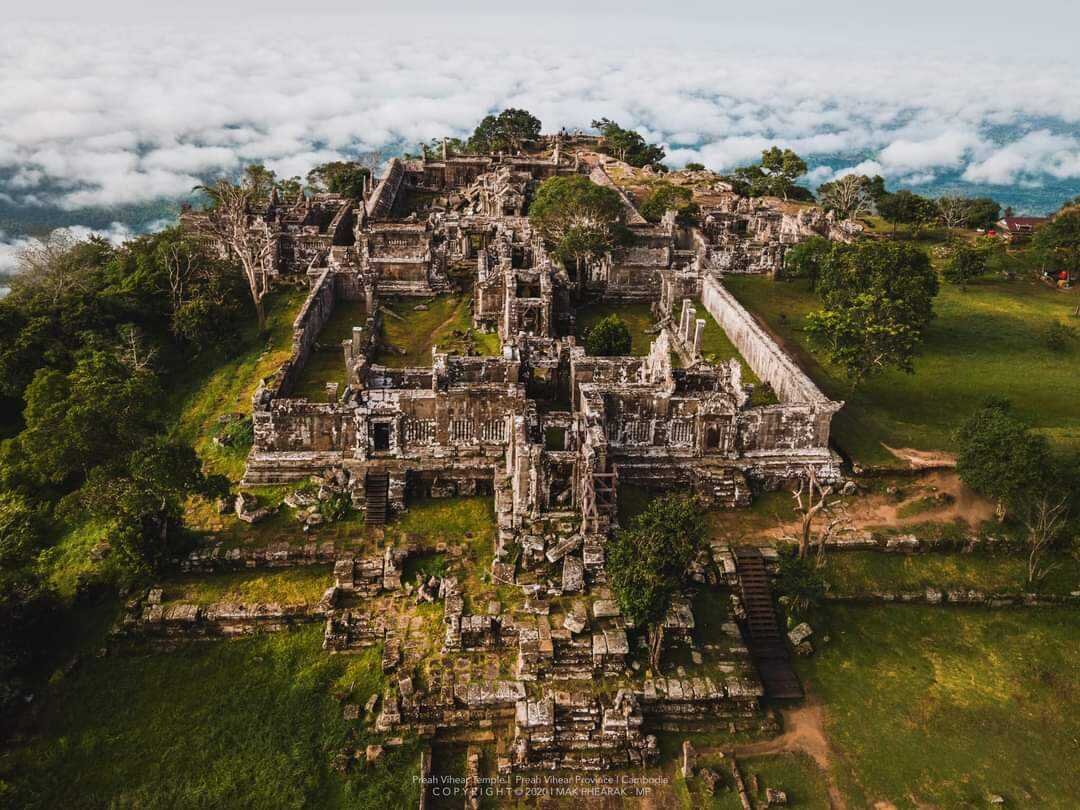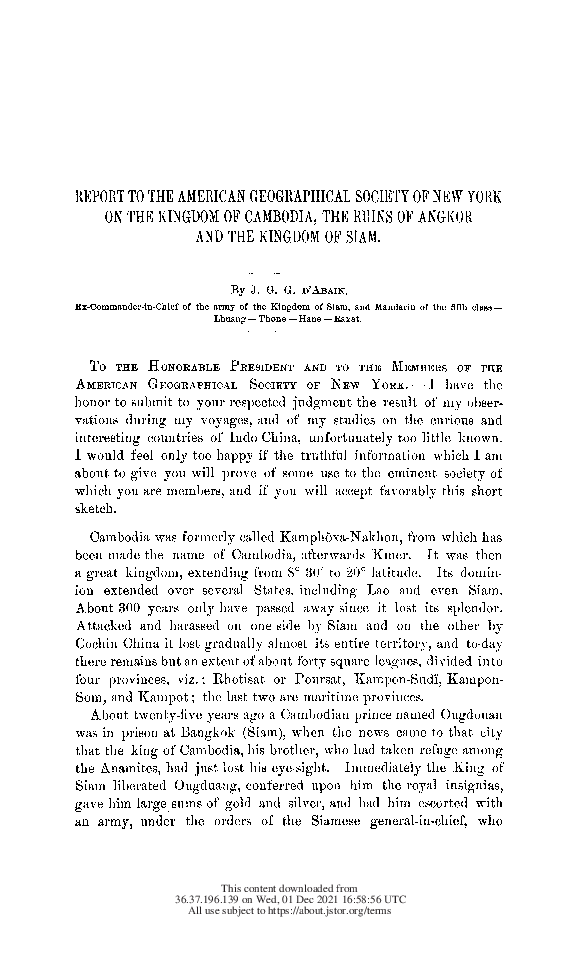Report On the Kingdom of Cambodia, the ruins of Angkor and the Kingdom of Siam
by Joseph-Georges Ganier
Notations on Angkor and Cambodian resources by an enigmatic traveler-adventurer, J.G.G. d'Aubain.

- Publication
- ournal of the American Geographical Society of New York , Vol. 7 (1875), pp. 333-356 | Taylor & Francis
- Published
- June 10th, 1875
- Author
- Joseph-Georges Ganier
- Pages
- 24
- Language
- English
pdf 2.6 MB
On June 10, 1875 (12 years after his presumed death), the French adventurer “G. D’Abain” submitted this report to the American Geographical Society of New York.
While following the rules of the genre — painstaking (and unreliable) demographic stats, brief considerations on potential economic benefits for America… – , these notes reflect some knowledge of the inner tensions the Kingdom of Siam (and Cambodia) were then going through, most of the author’s depictions of Angkor seem directly lifted from Henri Mouhot’s account, which was at the time raising much public interest across the English- and French-speaking worlds.
- About Angkor Wat: “The ruins consist in a vast palace, colonnades, pyramids and temples or pagodas; all of cut and chiseled marble. Some of the domes and arches are of such exquisite workmanship that the Cambodians never speak of them without stating that it is the work of angels and not of men. According to all probabilities, and from information I gathered on the very spot, these ruins date from the time of the famous Cambodian king, Phra-Pathum Suri-Wongse, under whose reign Somana-Khodom, a “talapoint” [Buddhist monk] of Ceylon, brought the sacred books of the Buddhists and introduced the religion of Buddha in that country, himself becoming a Buddhist and a great reformer of that religion.”
- About Siamese-Khmer relations: “This is what the annals relate with reference to this point: ” At this time the land of the Sajams [Siamese] was under the dominion of the king of Kamphoxa-Nakhon (Cambodia), and paid him a tribute. It is related that Phra-Ruang himself went to pay his respects and offer presents to the king of that country. Among them was a basket full of water, which did not escape through the interstices. The king of Kanmphoxa-Nakhon, amazed at such a miracle, formed the design to have Phra-Ruang murdered, fearing that should he be suffered to live, he would soon, through his genius, rise above all the other kings, but at the moment when the soldiers were about to seize Phra-Ruang to kill him, this prince, gifted witli the power of the Naghas (genii) sank down through the earth and disappeared; a few days later he was back in his dominiions. From that timie not only did Phra-Ruang pay no more tribute to the king of Kamphoxa, but he was compelled to acknowledge him as his liege. It was at this time that the Sajams took the name of Thais, which means ‘free.’ ”
- About demographics: “The population of that extensive country is not in proportion to its size; it is only about 8,000,000 inhabitants, who are distributed as follows: Siamese or Thais: 2,500,000; Chinese: 2,000,000; Malays: 1,800,000; Laos 400, 000; Cambodians: 800,000; Pegonans [people from Pegu, modern Bago, a Burmese city that was annexed by Jayavarman VII in 1195]:150,000; Birmans: 600, 000; Kariengs, Xongs, and Lavas 40,000; Klings, Arabs and Barmas: 50,000″.
- Samples of blatant plagiarism from Mouhot (whom he refers only once as “Mouhat”): “[On the southern gallery bas-relief], the punishments of the infernal regions are varied and numerous; and while the elect, who are enjoying themselves in paradise, are all fat and plump, the poor condemned beings are so lean that their bones show through their skin, and the expression of their faces is pitiful and full of a most comic seriousness. Some are being pounded in mortars, while others hold them by the feet and hands; some are being sawn asunder; others are led along like buffaloes, with ropes through their noses. In other places the comphubal (executioners) are cutting men to pieces with sabres, while a crowd of poor wretches are being transfixed by the tusks of elephants or on the horns of rhinoceros. Fabulous animals are busy devouring some; others are in irons, and have had their eyes.” Or: “The temple of Mount Bakheng appears to have been raised in the beginning of the civilization of the country, while that of Angkor-Wat was probably its climax.”
Tags: Nakhon, Siam, French explorers, 19th century
About the Author

Joseph-Georges Ganier
Joseph-Georges Ganin (23 Sept. 1840, Paris — [presumed] 6 Oct. 1873, Cartagena, Spain), also know as J.G.G. D’Abin or D’Abain, was a French adventurer, a globe-trotter, a military man fighting for nationalists and republicans, a pamphletist who spent several years in Siam and Cambodia, presumably as an opium dealer.
In 1863, he joined the Polish insurrection against the Russian and Prussian troops, and later on was rumored to having taken part in an insurrectional coup against the president of the Dominican Republic, which was probably a hoax.
In 1869, he served the young Siamese King Rama V as “commander-in-chief” of the Army, or as “Captain of the Guards”. The following year, he took a leave in order to serve the Commune de Paris against the Prussian armies. Commander of the National Guard, he was blamed for his behavior — including summary executions –, suspected to be a Bonapartist spy and even sentenced to death in absentia.
Back to Southeast Asia, he traveled by himself, and presumably authored a pamphlet published on January 1st, 1874, “Adventures of an Opium Monopolist in Cambodia”. He published articles about Cambodia in American journals, for instance The Century.
In a report to the American Geographical Society of New York in 1875 “about the Kingdom of Cambodia, the ruins of Angkor and the Kingdom of Siam”, he introduced himself as “Ex-Commander-in-Chief of the army of the Kingdom of Siam, and Mandarin of the fifth class — Lhuang — Thone — Hane — Raxat,” and signed “J.G.G. d’Abain [a variation on his pseudonym “D’Abin”, gentrification of his grandmother’s surname, Dabin (Jeanne)].
He was also named (rightly so, or as a part of his adventurer legend) as a fighter in several armed conflicts, such as infightings in Italy, in Abyssinia and during the 1873 – 1874 Spanish Revolution, rumored to have an affair with Mina Puccinelli (1835−1882), “Mina The Republican”, a revolutionary feminist. His presumed date of death,1873, is in contradiction with the fact that his wife Hyacinthe-Clarisse Ricou obtained a divorce sentence that was served to him in 1884.

